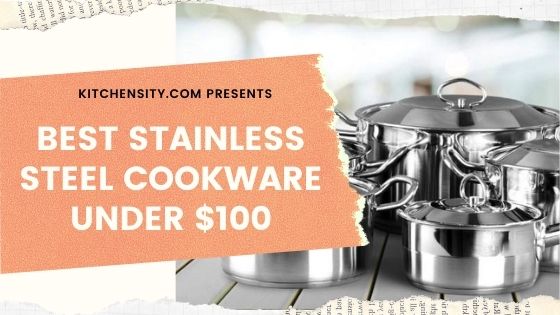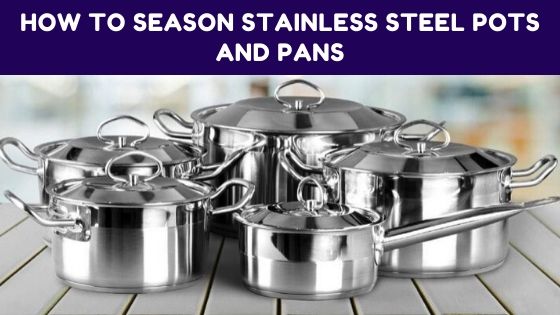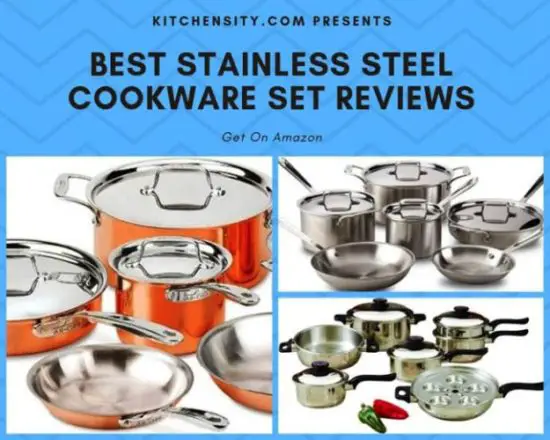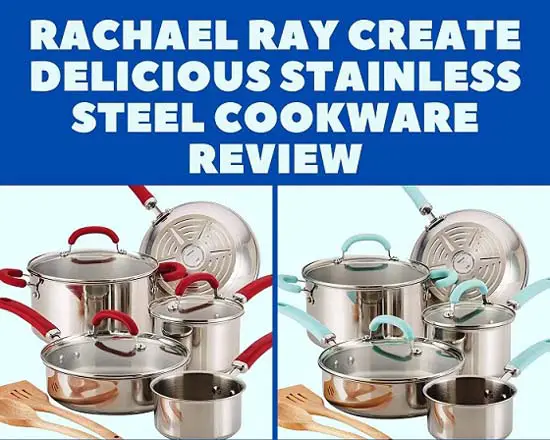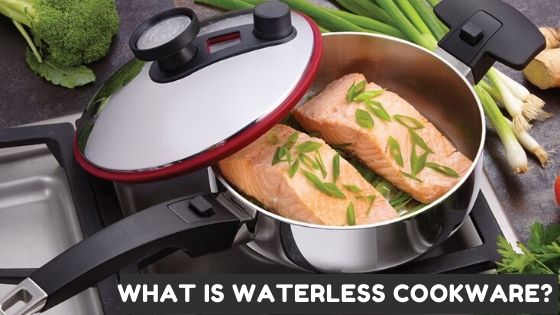I’ve always believed that the right tools can transform an ordinary task into a remarkable experience. When it comes to cooking, the choice of cookware can make all the difference. Among the options available, stainless steel cookware stands out as a timeless classic that embodies both elegance and functionality.
In this comprehensive guide, I’ll walk you through everything you need to know about buying stainless steel cookware, from understanding its properties to selecting the best set for your kitchen. So, if you’re ready to elevate your culinary journey, let’s dive into the world of stainless steel cookware together.
Table of Contents
- 1 What To Look For When Buying Stainless Steel Cookware?
- 2 Factors to Consider When Buying Stainless Steel Cookware
- 2.1 1. Grade Of Stainless Steel.
- 2.2 2. Importance Of Cookware Construction (3-Ply Or 5-Ply).
- 2.3 3. Importance Of Heat Conductivity.
- 2.4 4. Importance Of Handles And Lids.
- 2.5 5. Importance Of Cooking Surface.
- 2.6 6. Importance Of Price And Budget.
- 2.7 7. Importance Of Brand Reputation.
- 2.8 8. Importance Of Maintenance And Durability.
- 2.9 9. Importance Of Compatibility With Cooktops.
- 2.10 10. Importance Of Oven-Safe And Dishwasher Compatibility.
- 2.11 11. Importance Of Warranty Of Cookware.
- 2.12 12. Importance Of Aesthetics and Design Of The Cookware.
- 2.13 13. Importance Of Reviews And Recommendations.
- 3 What Is The Best Grade Of Stainless Steel Cookware?
- 4 How Can You Tell If Stainless Steel Is Good Quality?
- 5 What Are The 3 Grades Of Stainless Steel?
- 6 Final Thought For Buying Stainless Steel Cookware
- 7 Frequently Asked Questions (FAQs).
- 7.1 Which Is Better 18 10 Or 18 8 Stainless Steel?
- 7.2 Is 304 Stainless Steel Better Than 18 10?
- 7.3 What Is A Good Thickness For Stainless Steel Cookware?
- 7.4 Is Stainless Steel Cookware Safe For Cooking?
- 7.5 Which Grade Of Stainless Steel Is Best For Cookware?
- 7.6 Can Stainless Steel Cookware Be Used On Induction Cooktops?
- 7.7 What Should I Look For In A Good Stainless Steel Pan?
What To Look For When Buying Stainless Steel Cookware?
When buying stainless steel cookware, prioritize 18/10 grade for superior durability and corrosion resistance. This grade indicates the percentage of chromium (18%) and nickel (10%) in the alloy, which enhances its quality. Look for multi-layered bases or encapsulated bottoms, as these features promote even heat distribution and retention, crucial for precise cooking. Consider your budget, cooking needs, and the brand’s reputation to make a well-informed and worthwhile purchase that will serve you well in the kitchen for years to come.
![Buying Stainless Steel Cookware [Ultimate Guide With 13 Major Factors] 1 Buying Stainless Steel Cookware - An Ultimate Guide](https://www.kitchensity.com/wp-content/uploads/2023/07/What-To-Look-For-When-Buying-Stainless-Steel-Cookware-1024x576.webp)
Also Read – Best Stainless Steel Cookware Without Aluminum
Factors to Consider When Buying Stainless Steel Cookware
Here is a table of important factors to consider when buying stainless steel cookware.
| Aspect | Considerations |
| Material | Opt for high-quality stainless steel for durability and non-reactive cooking. |
| Cookware Construction | Look for multi-layered bases or encapsulated bottoms for even heat distribution. |
| Heat Conductivity | Consider cookware with added aluminum or copper for improved heat distribution. |
| Handles and Lids | Ensure securely riveted or welded handles and tight-fitting lids for safety and heat retention. |
| Cooking Surface | Choose a smooth and flat cooking surface for even cooking and easy food release. |
| Price and Budget | Set a budget and invest in high-quality cookware for better performance and longevity. |
| Compatibility with Cooktops | Verify compatibility with your specific cooktop, especially for induction stovetops. |
| Oven-Safe and Dishwasher Compatibility | Check if the cookware is oven-safe and dishwasher-compatible for convenience. |
| Warranty | Consider the length and coverage of the warranty to ensure protection and peace of mind. |
Also Read – Rachael Ray Create Delicious Stainless Steel Cookware Review
1. Grade Of Stainless Steel.
When purchasing stainless steel cookware, it’s important to focus on the grade of stainless steel used in its construction. The two most common grades are 18/8 and 18/10. These numbers represent the percentage of chromium and nickel in the alloy.
Here’s a breakdown of what these grades mean and how they affect the cookware’s performance:
- 18/8 Grade:
- This grade contains 18% chromium and 8% nickel.
- The presence of chromium provides excellent resistance to rust and corrosion.
- When exposed to oxygen, chromium forms a protective layer on the surface of the cookware, preventing it from reacting with its surroundings.
- While 18/8 stainless steel is durable, it may be slightly less resistant to corrosion compared to the 18/10 grade.
- 18/10 Grade:
- In this grade, the stainless steel contains 18% chromium and 10% nickel.
- The higher nickel content contributes to enhanced durability and superior corrosion resistance.
- Cookware made from 18/10 stainless steel is less likely to corrode or stain, making it a more reliable and long-lasting option.
So, the grade of stainless steel plays a significant role in determining the cookware’s quality and performance. When choosing between 18/8 and 18/10 stainless steel cookware, opting for the 18/10 grade ensures a higher level of corrosion resistance and longevity.
You May Also Like: How To Season Stainless Steel Pots And Pans?
2. Importance Of Cookware Construction (3-Ply Or 5-Ply).
Look for cookware that incorporates innovative design features like multi-layered bases. Cookware with a multi-layered base typically consists of multiple layers of different materials bonded together. One common design is the tri-ply construction, which combines stainless steel with aluminum or copper.
The benefits of tri-ply construction are significant. The stainless steel outer layer provides durability and a sleek appearance, while the aluminum or copper core enhances the cookware’s heat conductivity. Aluminum and copper are excellent conductors of heat, allowing them to quickly and evenly distribute heat across the cookware’s surface, preventing hotspots and ensuring uniform cooking.
In addition to tri-ply construction, there’s also 5-ply construction, which adds more layers to the cookware. While tri-ply has three layers (usually stainless steel/aluminum/stainless steel), 5-ply adds two more layers, often additional layers of stainless steel or aluminum. This extra layering can provide even more durability, heat retention, and distribution, but it can also increase the weight and cost of the cookware.
Cookware with a multi-layered base or an encapsulated bottom, combining stainless steel with aluminum or copper, offers superior heat conductivity. This ensures that your meals are cooked to perfection, making your culinary experiences enjoyable and hassle-free.
Also Read – Stainless Steel vs Nonstick vs Ceramic Cookware Set
3. Importance Of Heat Conductivity.
Heat conductivity is a crucial factor when buying stainless steel cookware because it determines how evenly and efficiently heat is distributed across the cooking surface. Stainless steel alone is not the best conductor of heat, which can lead to uneven cooking and hotspots. However, when stainless steel is combined with materials like aluminum or copper in multi-ply constructions, it improves heat conductivity. This allows for more even cooking, better control over the cooking process, and ultimately, tastier and more consistent results in your dishes.
Also Read – Best Stainless Steel Cookware Under $100
4. Importance Of Handles And Lids.
Handles and lids are important considerations when buying stainless steel cookware as they contribute to the overall functionality and safety of the cookware.
- Handles: Look for cookware with ergonomic handles that are comfortable to grip and stay cool during cooking. Riveted handles provide additional stability and durability, ensuring they stay securely attached to the cookware. Oven-safe handles allow for seamless transitions from stovetop to oven, adding versatility to your cooking options.
- Lids: Well-fitting lids help to retain heat and moisture during cooking, which is essential for certain cooking techniques and recipes. Glass lids can be beneficial as they allow you to monitor the cooking process without lifting the lid, which helps to maintain the desired temperature and avoid heat loss. Make sure the lids have sturdy handles that are easy to grip and stay cool for safe handling.
So, the handles and lids of cookware are essential features that impact its safety and functionality. Securely attached handles and heat-resistant materials ensure stability and safe handling during cooking.
Also Read – Carbon Steel Vs Stainless Steel Vs Cast Iron Pans
5. Importance Of Cooking Surface.
The cooking surface of stainless steel cookware is crucial because it directly impacts cooking performance and food release. Look for cookware with a smooth, non-reactive surface that is easy to clean and maintain. A well-designed cooking surface will resist staining, rusting, and flavor absorption, ensuring that your food retains its natural flavors. Also, a smooth cooking surface promotes even heat distribution, preventing hotspots and allowing for precise temperature control, which is essential for achieving optimal cooking results.
Also Read – Are Gotham Steel Pans Oven-Safe?
6. Importance Of Price And Budget.
Price and budget are important factors to consider when buying stainless steel cookware because they determine the quality and features you can afford. While higher-priced cookware often reflects better quality materials and construction, there are also good mid-range options available that offer a balance between quality and affordability. Consider your cooking needs, frequency of use, and long-term investment when setting your budget. It’s essential to find a balance between price and quality to ensure that you get the best value for your money and cookware that will meet your needs without breaking the bank.
So, setting a budget and investing in high-quality stainless steel cookware is a wise decision that can elevate your cooking experience. While high-quality options may be more expensive, their superior performance, durability, and versatility make them a valuable addition to your kitchen.
Also Read – Hard-Anodized Vs Stainless Steel Cookware
7. Importance Of Brand Reputation.
Brand reputation is important when buying stainless steel cookware because it reflects the quality, reliability, and customer satisfaction associated with a particular brand. Established brands with a good reputation often have a history of producing high-quality cookware that meets industry standards and customer expectations. By choosing a reputable brand, you can have more confidence in the performance and durability of the cookware, as well as the availability of customer support and warranty services.
Also, reputable brands are more likely to use quality materials and adhere to strict manufacturing standards, ensuring that you get a reliable product that will last for years to come. Reading customer reviews, seeking recommendations, and considering factors like longevity in the market and endorsements from chefs can help you identify brands that consistently deliver exceptional cookware.
Also Read – Is Stainless Steel Safe For Cooking?
8. Importance Of Maintenance And Durability.
Stainless steel is known for its durability, rust resistance, and ability to withstand high temperatures, making it a popular choice for cookware. Proper maintenance, such as regular cleaning and avoiding harsh abrasives, can help prolong the lifespan of stainless steel cookware. Look for cookware that is dishwasher-safe for easy cleaning and maintenance. Also, consider the thickness of the stainless steel, as thicker gauges are generally more durable and less prone to warping. Investing in durable stainless steel cookware can save you money in the long run, as it is less likely to need frequent replacement.
Also Read – Why Do Metal Handles Of Pans Get Hot?
9. Importance Of Compatibility With Cooktops.
Compatibility with cooktops is essential when buying stainless steel cookware because not all cookware is suitable for all types of cooktops. Stainless steel cookware is generally compatible with most cooktops, including gas, electric, and induction. However, it’s important to check the manufacturer’s specifications to ensure that the cookware is compatible with your specific cooktop. For example, induction cooktops require cookware with a magnetic base, so not all stainless steel cookware will work with induction stoves unless it has a magnetic layer or is specifically labeled as induction-compatible.
So, checking the compatibility of stainless steel cookware with your cooktop is crucial for ensuring efficient and effective cooking. If you have an induction stovetop, select induction-compatible cookware with a magnetic base. For gas, electric, glass-top, ceramic, or halogen cooktops, stainless steel cookware generally works well. A smooth and flat base is essential for even heat distribution, no matter the type of cooktop.
Also Read – Best Pans For Searing Fish
10. Importance Of Oven-Safe And Dishwasher Compatibility.
Oven-safe and dishwasher compatibility are important considerations when buying stainless steel cookware because they affect the versatility and ease of use of the cookware.
- Oven-Safe: Oven-safe cookware allows you to start cooking on the stovetop and finish in the oven without needing to transfer the food to a different dish. This is particularly useful for dishes that require both stovetop and oven cooking, such as braises or casseroles. Look for cookware with oven-safe handles and lids, as these can withstand the high temperatures of the oven without getting damaged.
- Dishwasher Compatibility: Dishwasher-safe cookware is convenient for easy cleaning and maintenance. It allows you to simply place the cookware in the dishwasher for hassle-free cleanup. However, not all stainless steel cookware is dishwasher-safe, so it’s important to check the manufacturer’s recommendations. Keep in mind that while stainless steel is generally resistant to rust and corrosion, harsh dishwasher detergents and abrasives can still affect its appearance over time.
Also Read – Hard Anodized Vs Cast Iron Cookware
11. Importance Of Warranty Of Cookware.
The warranty on stainless steel cookware is important as it reflects the manufacturer’s confidence in the product’s quality and durability. A longer warranty period indicates that the manufacturer is willing to stand behind their product and provides assurance to the buyer. When buying stainless steel cookware, consider the warranty length and what it covers, such as defects in materials or workmanship. Also, check if the warranty is prorated or has any conditions that might void it, such as improper use or maintenance.
So, a reliable warranty can provide you with peace of mind and assurance about the quality and durability of your stainless steel cookware. Check the length of the warranty, coverage details, and any exclusions to understand the extent of protection offered.
Also Read – Hard Anodized Vs Titanium Cookware
12. Importance Of Aesthetics and Design Of The Cookware.
The aesthetics and design of stainless steel cookware are important factors to consider, especially for those who value the appearance of their kitchen tools. Stainless steel cookware is known for its sleek and modern look, which can complement various kitchen styles. Also, well-designed cookware with thoughtful details such as ergonomic handles, secure lids, and attractive finishes can enhance the cooking experience and add a touch of elegance to your kitchen. While aesthetics should not be the sole consideration, choosing cookware that looks good and feels comfortable to use can enhance your overall cooking enjoyment.
While aesthetics may not directly impact the cookware’s performance, choosing visually appealing stainless steel cookware can elevate the ambiance of your kitchen. The sleek and modern appearance of stainless steel complements various kitchen styles and provides a touch of elegance to your culinary space.
Also Read – Ceramic Cookware Vs Aluminum Cookware
13. Importance Of Reviews And Recommendations.
Reviews and recommendations are valuable sources of information when buying stainless steel cookware as they provide insights from real users about the performance, durability, and overall satisfaction with the product. Reading reviews and seeking recommendations from friends, family, or trusted sources can help you make an informed decision, especially if you’re unfamiliar with specific brands or models.
Look for patterns in the reviews, paying attention to both positive and negative feedback to get a balanced view of the cookware’s strengths and weaknesses. This information can guide you in selecting cookware that aligns with your needs and preferences, ensuring that you make a well-informed purchase.
Also Read – Why Is Cast Iron Pan Sticky After Seasoning?
What Is The Best Grade Of Stainless Steel Cookware?
The best grade of stainless steel cookware is generally considered to be 18/10 stainless steel. This grade refers to the stainless steel composition, with 18% chromium and 10% nickel content.
Why 18/10 stainless steel is regarded as the top choice for cookware?
18/10 stainless steel is regarded as the top choice for cookware due to its high quality and beneficial properties. With 18% chromium and 10% nickel, this alloy offers excellent corrosion resistance, durability, and a non-reactive surface that is easy to clean. It maintains its appearance even with regular use and is suitable for a wide range of cooking tasks, making it a popular choice for both home and professional kitchens.
It’s essential to note that while 18/10 stainless steel is considered the best grade, there are other grades available, such as 18/8 and 18/0, which have slightly different compositions. However, 18/10 is generally favored for its superior durability, corrosion resistance, and overall performance, making it an excellent choice for professional chefs and home cooks alike.
Also Read – What To Look For When Buying Non-Stick Cookware?
How Can You Tell If Stainless Steel Is Good Quality?
You can tell if the stainless steel is good quality by checking its grade, weight, construction, finish, magnetism (if you need it for induction cooking), and the reputation of the brand. Look for stainless steel with a higher grade (like 18/10 or 18/8), heavier weight, multi-ply or clad construction, smooth finish, magnetic base if needed, and a reputable brand known for quality. These factors indicate better durability, resistance to corrosion, and overall quality.
What Are The 3 Grades Of Stainless Steel?
The three main grades of stainless steel commonly used in cookware are 18/10 Stainless Steel, 18/8 Stainless Steel, and 18/0 Stainless Steel.
- 18/10 Stainless Steel: This grade contains 18% chromium and 10% nickel, which provides excellent resistance to corrosion, durability, and a lustrous finish.
- 18/8 Stainless Steel: Similar to 18/10 stainless steel, this grade contains 18% chromium and 8% nickel. While slightly less nickel content than 18/10, it still offers good corrosion resistance and durability.
- 18/0 Stainless Steel: This grade contains 18% chromium and no nickel. While it is less expensive than 18/10 and 18/8 stainless steel, it is also less resistant to corrosion and may not have the same level of durability and luster.
Also Read – Is Stainless Steel Cookware Nonstick?
Final Thought For Buying Stainless Steel Cookware
In conclusion, purchasing stainless steel cookware requires careful consideration of several factors. From the grade of stainless steel to the construction, thickness, and compatibility with your cooking needs, each aspect contributes to the overall quality and performance of the cookware. Additionally, paying attention to details such as handles, lids, and maintenance requirements can enhance the usability and longevity of your investment.
By evaluating these factors and choosing reputable brands, you can select stainless steel cookware that not only meets your cooking needs but also offers durability, functionality, and value for your kitchen.
You May Also Like: What is Waterless Cookware? How does it work?
Frequently Asked Questions (FAQs).
-
Which Is Better 18 10 Or 18 8 Stainless Steel?
18/10 stainless steel is better than 18/8 due to its higher nickel content, enhancing durability and corrosion resistance.
-
Is 304 Stainless Steel Better Than 18 10?
Both 304 stainless steel and 18/10 are of high quality; 304 is a grade within the 18/8 category, making them comparable in performance.
-
What Is A Good Thickness For Stainless Steel Cookware?
A good thickness for stainless steel cookware is typically between 2.5mm to 3.0mm, offering durability and even heat distribution.
-
Is Stainless Steel Cookware Safe For Cooking?
Yes, stainless steel cookware is safe for cooking. It is non-reactive and does not leach harmful chemicals into your food.
-
Which Grade Of Stainless Steel Is Best For Cookware?
The 18/10 grade of stainless steel is considered the best for cookware due to its higher nickel content, providing enhanced corrosion resistance.
-
Can Stainless Steel Cookware Be Used On Induction Cooktops?
Not all stainless steel cookware is compatible with induction cooktops. Look for sets with a magnetic base that ensures proper induction heating.
-
What Should I Look For In A Good Stainless Steel Pan?
When looking for a good stainless steel pan, prioritize multi-ply or clad construction for even heat distribution and durability. Choose a thickness that ensures even heating and prevents warping. Look for a thick, flat base and sturdy, ergonomic handles. Ensure compatibility with your cooktop, and consider a smooth, polished interior for easy cleaning. Finally, purchase from reputable brands known for quality and customer satisfaction.
Katrina Smith is a seasoned expert with over 25 years of experience in all things related to cooking and the kitchen. As an avid cook and kitchen enthusiast, she is passionate about sharing her knowledge and expertise on cookware, kitchen appliances, kitchen tips, and kitchen staples.
Through her articles and reviews, Katrina aims to inspire and help others improve their cooking skills, experiment with different ingredients, and invest in quality cookware and appliances.

